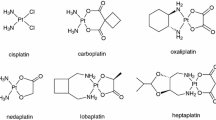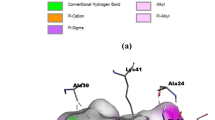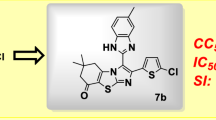Abstract
\((E)\)-6-Hydroxy-9-methoxy-6-(piperazin-1-yl)-11\(H\)-indeno[1,2-\(c\)]quinolin-11-one \(O\)-2-(pyrrolidin-1-yl)ethyl oxime (2c) was identified as a potential dual topo I/II inhibitor in our previous paper. In continuation for the search of more potent compounds, we describe herein the preparation of certain indeno[1,2-\(c\)]quinoline derivatives and evaluation of their antiproliferation, DNA binding affinity, and topoisomerases (topo I and topo II) inhibitory activities. Among them, \((E)\)-9-[3-(dimethylamino)propoxy]-11\(H\)-indeno[1,2-\(c\)]quinolin-11-one \(O\)-3-(dimethylamino)propyl oxime (11b) and its analog 11c exhibited approximately equal activity to the lead compound 2c against the growth of HeLa and A549 cancer cells. Both compounds 11b and 11c were more active than 2c in the inhibition of topo I and topo II. However, none of them exhibited significant DNA binding affinity while 2c was a very strong DNA binding agent. Compound 11b exhibited a high oral bioavailability of 39.8 % while the oral bioavailability of 2c and 11c was only 10.9 and 8.6 %, respectively. The in vivo anti-tumor evaluation of 11b in nude mice bearing subcutaneous breast cancer tumors revealed that treatment with low (10 mg/kg) or high (30 mg/kg) doses of 11b dramatically diminished tumor growth. Therefore, compound 11b is identified as a potential non-DNA intercalating dual topo I/II inhibitor.









Similar content being viewed by others
References
Coban G, Zencir S, Zupko I, Rethy B, Gunes HS, Topcu Z (2009) Synthesis and biological activity evaluation of 1\(H\)-benzimidazoles via mammalian DNA topoisomerase I and cytostaticity assays. Eur J Med Chem 44:2280–2285. doi: 10.1016/j.ejmech.2008.06.018
Feng W, Satyanarayana M, Tsai YC, Liu AA, Liu LF, LaVoie EJ (2009) 12-Substituted 2,3-dimethoxy-8,9-methylene- dioxybenzo[\(i\)]phenanthridines as novel topoisomerase I-targeting antitumor agents. Bioorg Med Chem 17:2877–2885. doi: 10.1016/j.bmc.2009.02.023
Sunami S, Nishimura T, Nishimura I, Ito S, Arakawa H, Ohkubo M (2009) Synthesis and biological activities of topoisomerase I inhibitors, 6-arylmethylamino analogues of edotecarin. J Med Chem 52:3225–3237. doi:10.1021/jm801641t
Feng W, Satyanarayana M, Tsai YC, Liu AA, Liu LF, La V, Edmond J (2009) Novel topoisomerase I-targeting antitumor agents synthesized from the N,N,N-trimethylammonium derivative of ARC-111, 5\(H\)-2,3-dimethoxy-8,9-methylenedioxy-5-[(2-N,N,N-trimethyl ammonium)-ethyl]dibenzo[c,h][1,6]naphthyridin-6-one iodide. Eur J Med Chem 44:3433–3438. doi: 10.1016/j.ejmech.2009.02.004
You QD, Li ZY, Huang CH, Yang Q, Wang XJ, Guo QL, Chen XG, He XG, Li TK, Chern JW (2009) Discovery of a novel series of quinolone and naphthyridine derivatives as potential topoisomerase I inhibitors by scaffold modification. J Med Chem 52:5649–5661. doi:10.1021/jm900469e
Diwan R, Malpathak N (2009) Furanocoumarins: novel topoisomerase I inhibitors from Ruta graveolens L. Bioorg Med Chem 17:7052–7055. doi:10.1016/j.bmc.2009.04.023
Cinelli MA, Cordero B, Dexheimer TS, Pommier Y, Cushman M (2009) Synthesis and biological evaluation of 14-(aminoalkyl-aminomethyl)aromathecins as topoisomerase I inhibitors: investigating the hypothesis of shared structure–activity relationships. Bioorg Med Chem 17:7145–7155. doi:10.1016/j.bmc.2009.08.066
Song Y, Shao Z, Dexheimer TS, Scher ES, Pommier Y, Cushman M (2010) Structure-based design, synthesis, and biological studies of new anticancer norindenoisoquinoline topoisomerase I inhibitors. J Med Chem 53:1979–1989. doi:10.1021/jm901649x
Guo W, Miao Z, Sheng C, Yao J, Feng H, Zhang W, Zhu L, Liu W, Cheng P, Zhang J, Che X, Wang W, Luo C, Xu Y (2010) Synthesis and evaluation of 9-benzylideneamino derivatives of homocamptothecin as potent inhibitors of DNA topoisomerase I. Eur J Med Chem 45:2223–2228. doi:10.1016/j.ejmech.2010.01.063
Loza-Mejia MA, Olvera-Vazquez S, Maldonado-Hernandez K, Guadarrama-Salgado T, Gonzalez-Sanchez I, Rodriguez-Hernandez F, Solano JD, Rodriguez-Sotres R, Lira-Rocha A (2009) Synthesis, cytotoxic activity, DNA topoisomerase-II inhibition, molecular modeling and structure–activity relationship of 9-anilinothiazolo[5,4-\(b\)]quinoline derivatives. Bioorg Med Chem 17:3266–3277. doi: 10.1016/j.bmc.2009.03.052
Ryckebusch A, Garcin D, Lansiaux A, Goossens JF, Baldeyrou B, Houssin R, Bailly C, Hénichart JP (2008) Synthesis, cytotoxicity, DNA interaction, and topoisomerase II inhibition properties of novel indeno[2,1-\(c\)]quinolin-7-one and indeno[1,2-\(c\)]isoquinolin-5,11-dione derivatives. J Med Chem 51:3617–3629. doi: 10.1021/jm800017u
Sperry J, Lorenzo-Castrillejo I, Brimble MA, Machin F (2009) Pyranonaphthoquinone derivatives of eleutherin, ventiloquinone L, thysanone and nanaomycin A possessing a diverse topoisomerase II inhibition and cytotoxicity spectrum. Bioorg Med Chem 17: 7131–7137. doi:10.1016/j.bmc.2009.08.064
Chen Z, Liang X, Zhang H, Xie H, Liu J, Xu Y, Zhu W, Wang Y, Wang X, Tan S, Kuang D, Qian X (2010) A new class of naphthalimide-based antitumor agents that inhibit topoisomerase II and induce lysosomal membrane permeabilization and apoptosis. J Med Chem 53:2589–2600. doi:10.1021/jm100025u
Huang H, Chen Q, Xin K, Meng L, Lin L, Wang X, Zhu C, Wang Y, Chen Z, Li M, Jiang H, Chen K, Ding J, Liu H (2010) A series of \(\alpha \)-heterocyclic carboxaldehyde thiosemicarbazones inhibit topoisomerase II alpha catalytic activity. J Med Chem 53:3048–3064. doi: 10.1021/jm9014394
Leon LG, Rios-Luci C, Tejedor D, Perez-Roth E, Montero JC, Pandiella A, Garcia-Tellado F, Padron JM (2010) Mitotic arrest induced by a novel family of DNA topoisomerase II inhibitors. J Med Chem 53:3835–3839. doi:10.1021/jm100155y
VanG R, Lendfers RRH, Schellens JHM, Bult A, Beijnen JH (2000) Dual topoisomerase I/II inhibitors. J Oncol Pharm Pract 6:92–108. doi:10.1177/107815520000600303
Rao VA, Agama K, Holbeck S, Pommier Y (2007) Batracylin (NSC 320846), a dual inhibitor of DNA topoisomerases I and II induces histone \(\gamma \)-H2AX as a biomarker of DNA damage. Cancer Res 67:9971–9979. doi: 10.1158/0008-5472.CAN-07-0804
Wang S, Miller W, Milton J, Vicker N, Stewart A, Charlton P, Mistry P, Hardick D, Denny WA (2002) Structure–activity relationships for analogues of the phenazine-based dual topoisomerase I/II inhibitor XR11576. Bioorg Med Chem Lett 12:415–418. doi:10.1016/S0960-894X(01)00770-3
Vicker N, Burgess L, Chuckowree IS, Dodd R, Folkes AJ, Hardick DJ, Hancox TC, Miller W, Milton J, Sohal S, Wang S, Wren SP, Charlton PA, Dangerfield W, Liddle C, Mistry P, Stewart AJ, Denny WA (2002) Novel angular benzophenazines: dual topoisomerase I and topoisomerase II inhibitors as potential anticancer agents. J Med Chem 45:721–739. doi:10.1021/jm010329a
Perrin D, van Hille B, Barret JM, Kruczynski A, Etievant C, Imbert T, Hill BT (2000) F 11782, a novel epipodophylloid non-intercalating dual catalytic inhibitor of topoisomerases I and II with an original mechanism of action. Biochem Pharmacol 59:807–819. doi:10.1016/S0006-2952(99)00382-2
Karki R, Thapa P, Kang MJ, Jeong TC, Nam JM, Kim HL, Na Y, Cho WJ, Kwon Y, Lee ES (2010) Synthesis, topoisomerase I and II inhibitory activity, cytotoxicity, and structure–activity relationship study of hydroxylated 2,4-diphenyl-6-aryl pyridines. Bioorg Med Chem 18:3066–3077. doi:10.1016/j.bmc.2010.03.051
Thapa P, Karki R, Choi H, Choi JH, Yun M, Jeong BS, Jung MJ, Nam JM, Na Y, Cho WJ, Kwon Y, Lee ES (2010) Synthesis of 2-(thienyl-2-yl or -3-yl)-4-furyl-6-aryl pyridine derivatives and evaluation of their topoisomerase I and II inhibitory activity, cytotoxicity, and structure–activity relationship. Bioorg Med Chem 18:2245–2254. doi:10.1016/j.bmc.2010.01.065
Utsugi T, Aoyagi K, Asao T, Okazaki S, Aoyagi Y, Sano M, Wierzba K, Yamada Y (1997) Antitumor activity of a novel quinoline derivative, TAS-103, with inhibitory effects on topoisomerases I and II. Jpn J Cancer Res 88:992–1002. doi:10.1111/j.1349-7006.1997.tb00320.x
Aoyagi Y, Kobunai T, Utsugi T, Oh-hara T, Yamada Y (1999) In vitro antitumor activity of TAS-103, a novel quinoline derivative that targets topoisomerases I and II. Jpn J Cancer Res 90:578–587. doi:10.1111/j.1349-7006.1999.tb00786.x
Ishida K, Asao T (2002) Self-association and unique DNA binding properties of the anti-cancer agent TAS-103, a dual inhibitor of topoisomerases I and II. Biochim Biophys Acta 1587:155–163. doi:10.1016/S0925-4439(02)00078-9
Byl JA, Fortune JM, Burden DA, Nitiss JL, Utsugi T, Yamada Y, Osheroff N (1999) DNA topoisomerases as targets for the anticancer drug TAS-103: primary cellular target and DNA cleavage enhancement. Biochemistry 38:15573–15579. doi:10.1021/bi991791o
Torigoe T, Izumi H, Wakasugi T, Niina I, Igarashi T, Yoshida T, Shibuya I, Chijiiwa K, Matsuo K, Itoh H, Kohno K (2005) DNA topoisomerase II poison TAS-103 transactivates GC-box-dependent transcription via acetylation of Sp1. J Biol Chem 280:1179–1185. doi:10.1074/jbc.M410499200
Yoshida M, Kabe Y, Wada T, Asai A, Handa H (2008) A new mechanism of TAS-103 action discovered by target screening with drug-immobilized affinity beads. Mol Pharmacol 73:987–994. doi:10.1124/mol.107.043307
Tseng CH, Chen YL, Lu PJ, Yang CN, Tzeng CC (2008) Synthesis and antiproliferative evaluation of certain indeno[1,2-\(c\)]quinoline derivatives. Bioorg Med Chem 15:3151–3162. doi: 10.1016/j.bmc.2007.12.028
Tseng CH, Tzeng CC, Yang CL, Lu PJ, Chen HL, Li HY, Chuang YC, Yang CN, Chen YL (2010) Synthesis and antiproliferative evaluation of certain indeno[1,2-\(c\)]quinoline derivatives. Part 2. J Med Chem 53:6164–6179. doi: 10.1021/jm1005447
Tseng CH, Lin RW, Chen YL, Wang GJ, Ho ML, Tzeng CC (2011) Discovery of indeno[1,2-\(c\)]quinoline derivatives as inhibitors of osteoclastogenesis induced by receptor activator of NF-\(\kappa \) B ligand (RANKL). J Med Chem 54:3103–3107. doi: 10.1021/jm1016494
Shearman MS, Ragan CI, Iversen LL (1994) Inhibition of PC12 cell redox activity is a specific, early indicator of the mechanism of beta-amyloid-mediated cell death. Proc Natl Acad Sci USA 91: 1470–1474. doi:10.1073/pnas.91.4.1470
Chowdhury AR, Sharma S, Mandal S, Goswami A, Mukhopadhyay S, Majumder HK (2002) Luteolin, an emerging anti-cancer flavonoid, poisons eukaryotic DNA topoisomerase I. Biochem J 366:653–661. doi:10.1042/BJ20020098
Gillson BS, Ross WE (1987) DNA topoisomerase II: a primer on the enzyme and its unique role as a multidrug target in cancer chemotherapy. Pharmacol Ther 32:89–106. doi:10.1016/0163-7258(87)90054-4
Lu PJ, Zhou XZ, Liou YC, Noel JP, Lu KP (2002) Critical role of WW domain phosphorylation in regulating phosphoserine binding activity and pin1 function. J Biol Chem 277:2381–2384. doi:10.1074/jbc.C100228200
Cramer RD, Patterson DE, Bunce JD (1988) Comparative molecular field analysis (CoMFA). 1. Effect of shape on binding of steroid to carrier proteins. J Am Chem Soc 110:5959–5967. doi:10.1021/ja00226a005
Acknowledgments
Financial support of this work by the National Science Council of the Republic of China (NSC 99-2320-B-037-011-MY3, NSC 99-2628-B-037-005-MY3, and NSC 101-2320-B-037-039-MY3) is gratefully acknowledged. We also thank the National Center for High-Performance Computing for providing computer resources and chemical database services.
Author information
Authors and Affiliations
Corresponding authors
Electronic supplementary material
Below is the link to the electronic supplementary material.
Rights and permissions
About this article
Cite this article
Tseng, CH., Tzeng, CC., Yang, CL. et al. Discovery of indeno[1,2-\(c\)]quinoline derivatives as dual topoisomerases I/II inhibitors: Part 3. Mol Divers 17, 781–799 (2013). https://doi.org/10.1007/s11030-013-9475-5
Received:
Accepted:
Published:
Issue Date:
DOI: https://doi.org/10.1007/s11030-013-9475-5




